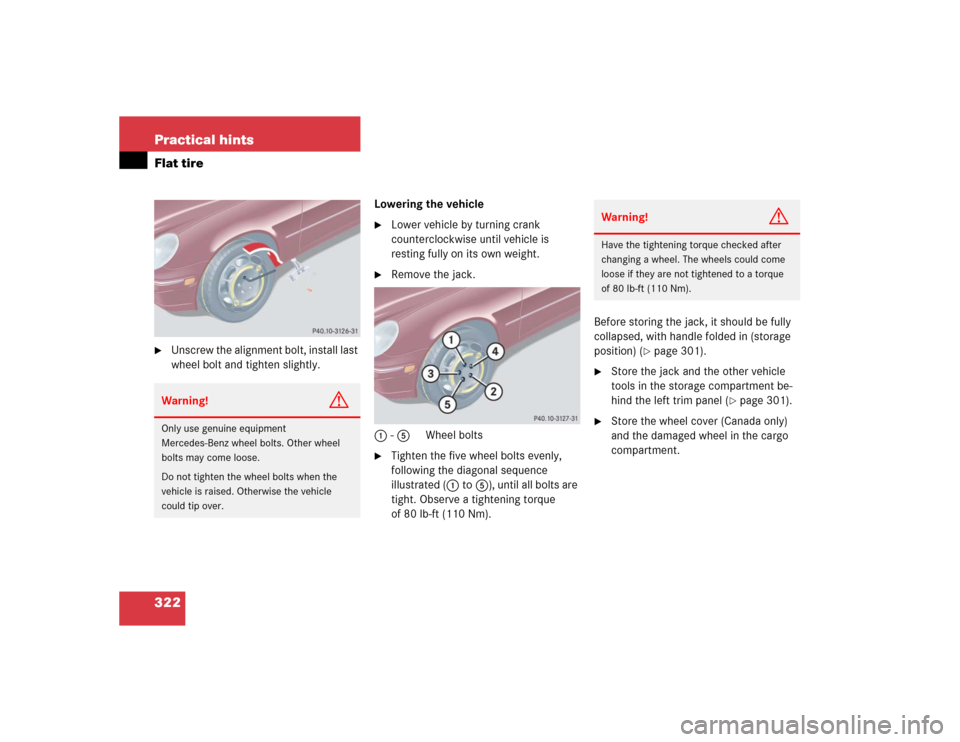Page 262 of 400

262 OperationTires and wheelsTire pressure changes by approx. 1.5 psi
(0.1 bar) per 18°F (10°C) of air tempera-
ture change. Keep this in mind when
checking tire pressure where the tempera-
ture is different from the outside tempera-
ture.
Tire temperature and tire pressure are also
increased while driving, depending on the
driving speed and the tire load.
Check the spare tire periodically for condi-
tion and inflation. Spare tires will age and
become worn over time even if never used,
and thus should be inspected and replaced
when necessary.
Rotating wheels
On vehicles with the same wheel size all
around, wheels can be rotated every 3 000
to 6 000 miles (5 000 to 10 000 km), or
sooner if necessary, according to the
degree of tire wear. The same direction of
tire rotation must be retained.Rotate the wheels before the characteris-
tic tire wear pattern becomes visible
(shoulder wear on front wheels and tread
center wear on rear wheels).
Thoroughly clean the inner side of the
wheels after each rotation. Check and
ensure proper tire inflation pressure.
Warning!
G
Follow recommended inflation pressures.
Do not overinflate tires. Overinflated tires
can result in sudden deflation (blowout)
because they are more likely to become
punctured or damaged by road debris,
potholes, etc.
Do not underinflate tires. Underinflated tires
wear unevenly, adversely affect handling
and fuel economy, and are more likely to fail
from being overheated.
Do not overload the tires by exceeding the
specified vehicle capacity weight (as indi-
cated by the label on the pillar in the driver’s
door opening). Overloading the tires can
overheat them, possibly causing a blowout.Warning!
G
Rotate front and rear wheels only if they are
of the same size.
Warning!
G
Have the tightening torque checked after
changing a wheel. Wheels could become
loose if not tightened with a torque of
80 lb-ft (110 Nm).
Only use genuine Mercedes-Benz wheel
bolts specified for your vehicle's rims.
Page 322 of 400

322 Practical hintsFlat tire�
Unscrew the alignment bolt, install last
wheel bolt and tighten slightly.Lowering the vehicle
�
Lower vehicle by turning crank
counterclockwise until vehicle is
resting fully on its own weight.
�
Remove the jack.
1 - 5Wheel bolts
�
Tighten the five wheel bolts evenly,
following the diagonal sequence
illustrated (1to5), until all bolts are
tight. Observe a tightening torque
of 80 lb-ft (110 Nm).Before storing the jack, it should be fully
collapsed, with handle folded in (storage
position) (
�page 301).
�
Store the jack and the other vehicle
tools in the storage compartment be-
hind the left trim panel (
�page 301).
�
Store the wheel cover (Canada only)
and the damaged wheel in the cargo
compartment.
Warning!
G
Only use genuine equipment
Mercedes-Benz wheel bolts. Other wheel
bolts may come loose.
Do not tighten the wheel bolts when the
vehicle is raised. Otherwise the vehicle
could tip over.
Warning!
G
Have the tightening torque checked after
changing a wheel. The wheels could come
loose if they are not tightened to a torque
of 80 lb-ft (110 Nm).
Page 361 of 400

361 Technical terms
Tele Aid* System
(T
elematic A
larm I
dentification on
D
emand)
The Tele Aid system consists of three
types of response: automatic and
manual emergency, roadside assis-
tance and information. Tele Aid is
initially activated by completing a
subscriber agreement and placing an
acquaintance call.
The Tele Aid system is operational
provided that the vehicle’s battery is
charged, properly connected, not
damaged and cellular and GPS
coverage is available.Telematics*
A combination of the terms “tele-
communications” and “informatics”.
Tightening torque
Force times lever arm (e.g. a lug
wrench) with which threaded fasteners
such as wheel bolts are tightened.
Tire speed rating
Part of tire designation; indicates the
speed range for which a tire is
approved.Traction
Force exerted by the vehicle on the
road via the tires.
VIN
(V
ehicle I
dentification N
umber)
The number set by the manufacturer
and placed on the body to uniquely
identify each vehicle produced.
Voice control system*
Voice control system for car phones,
portable cell phones and audio
systems (radio, CD, etc.).
Page 388 of 400

388 Index
Messages in display 299
Operating 136
Operation 189
Redialing 138
Signal strength 137
Temperature
Display mode 125
Grades of tires 356
Setting interior temperature 152
Setting units in display 125
Tires 262
Tie-down rings
(Cargo compartment) 214
Tightening torque (Wheel bolts) 322
Tilt
Head restraint 34
Time
Setting hours 124
Setting minutes 124Time display
Setting 125
Tire inflation pressure
Checking 251, 261
Tire speed rating 243
Tire traction 243
Tires 260, 341
Consumer information 355
Direction of rotation 261
Driving instructions 242
Retreads 260
Rims and tires 341
Service life 261
Temperature 262
Temperature grades 356
Traction 355
Tread depth 263
Wear pattern 262
Winter 263
Tools 300Tow-away alarm 25
Arming 81
Disarming 81
Disarming for transport 81
Tow-away alarm* 81
Towing eye bolt (vehicle tool kit)
Installing 332
Towing the vehicle 329
Tracking services
For stolen vehicle 230
Traction 144, 361
Traction (Tires) 355
Transmission gear selector lever 308
Unlocking manually 308
Transmission see Automatic transmission
Traveling abroad 245
Tread depth (tires) 263
Tread wear 355
Trim panel
Opening 334